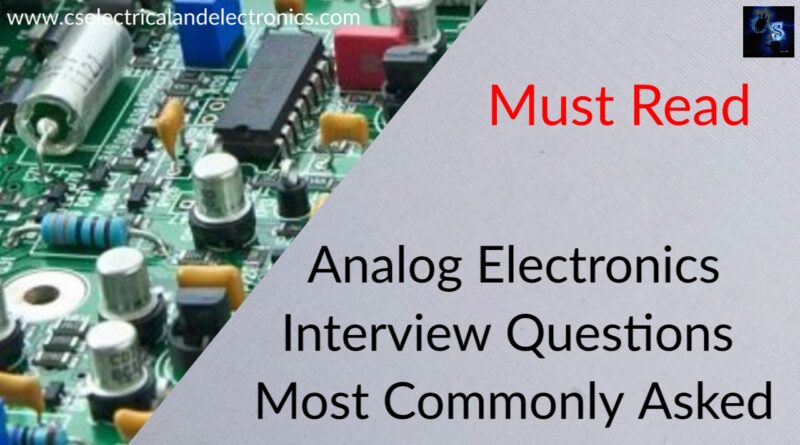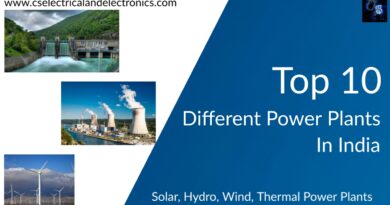Analog Electronics Interview Questions Most Commonly Asked
Hello guys, welcome back to my blog. In this article, I will discuss analog electronics interview questions most commonly asked during interviews, interview questions on analog electronics, etc.
If you have any doubts related to electrical, electronics, and computer science, then ask questions. You can also catch me on Instagram – Chetan Shidling.
Also, read:
- Automotive Electronics Interview Questions For Engineers, Automobile.
- Cpp Interview Questions, Object-Oriented Programming Questions.
- 1000+ Interview Questions On Java, Java Interview Questions, Freshers.
Analog Electronics Interview Questions
01. Define conductors, insulators, semiconductors with examples?
02. Explain briefly the energy band diagrams of conductors, insulators, and semiconductors?
03. Differentiate conductors, insulators, and semiconductors?
04. List the properties of semiconductors?
05. Define hole current, electron-hole pairs, and recombinations?
06. Define doping, acceptor, and donor impurities?
07. Differentiate Intrinsic and extrinsic semiconductors?
08. Explain P and N type semiconductors with covalent bond diagram?
09. Define diode and explain depletion region in PN junction?
10. Explain the forward and reverse bias characteristics of diode?
11. Explain the VI characteristics of diode?
12. List the types of diodes with their applications and ratings?
13. Explain the reverse bias characteristics of Zener diode?
14. Define regulation and explain the working of Zener voltage regulator?
15. Define Zener diode and list the applications?
16. Explain the working of varistor?
17. Explain the working of thermistor?
18. List the applications of Varistor and Thermistor?
19. Define transistor and mention the function of each terminal?
20. List the types of transistors?
21. Explain the formation of NPN and PNP transistors?
22. Explain the working of NPN transistor?
23. List the ratings and applications of transistors?
24. Define transistor biasing and its necessity. Also, list the types?
25. Define stabilization, thermal runway, and heat sink?
26. Explain the voltage divider method of biasing?
27. List the transistor configurations with their applications?
29. Derive the relation between Alpha and Beta?
30. Explain the transistor CE characteristics?
31. Sketch transistor characteristics to show cut off, saturation and active regions?
32. Briefly explain cut off, saturation, and active region?
33. Explain transistor as a switch?
35. Explain the construction of MOSFET?
36. Explain the working of MOSFET?
37. Sketch and explain the MOSFET characteristics?
38. Explain MOSFET as a switch?
39. List MOSFET ratings and applications?
40. Differentiate BJT and MOSFET?
41. Sketch the block diagram of regulated power supply and list the components?
42. List the applications of regulated power supply?
43. Define rectifier and list the applications?
44. Define rectifier efficiency, ripple factor, and PIV?
45. Explain the working of a half wave rectifier?
46. Explain the working of full wave center tapped rectifier?
47. Explain the working of full wave bridge rectifier?
48. List the values for efficiency, ripple factor, and diode PIV for different rectifiers?
49. Define filter and its necessity?
50. Describe the working of C filter?
51. Describe the working of PI filter?
52. Define voltage regulator and list the operating voltages of 78xx and 79xx series?
53. Sketch and explain the working of 7805 voltage regulator?
54. Define amplifier and give the classification of amplifiers?
55. Define faithful amplification?
56. Describe the working of transistor CE amplifier?
57. Explain the working of class A amplifier?
58. Explain the working of class B amplifier?
59. Explain the working of C amplifier?
60. Explain the working of push pull amplifier?
61. Explain the working of two stage RC coupled amplifier?
62. Define gain in db and frequency response?
63. Define feedback and list the types with their applications?
64. Explain briefly positive and negative feed back?
65. List the advantages and disadvantages of negative feed back?
67. Classify the different types of oscillators?
68. Explain Bark hauvsen criteria for obtaining oscillation?
69. Explain LC tank oscillation circuit?
70. Explain the working of RC phase shift oscillator?
71. Explain the working of crystal oscillator?
72. Describe the construction of CRT?
73. Explain the working of CRT?
74. List the applications of oscillators?
75. Define Op-Amp. List the applications?
76. Sketch and explain the block diagram of OP-AMP?
77. List the characteristics of Op-Amp?
78. Define virtual ground, CMRR, and slew rate?
79. Describe Op-Amp as Inverting amplifier?
80. Describe Op-Amp integrator circuit?
81. Explain Op-Amp differentiator circuit?
83. Sketch and explain voltage follower and comparator?
84. Define passive and active filters?
85. Define low pass and high pass filter?
86. Explain the working of passive low pass and high pass filters?
87. Explain the working of active low pass and high pass filters?
88. List the applications of filters?
89. Define timer and sketch the block diagram?
90. Sketch the pin diagram of 555 timer and label them?
91. Define time constant and duty cycle?
92. List the applications of 555 timer?
93. Define multi-vibrator. List the types?
94. Explain 555 timer as astable multi-vibrator?
95. Explain 555 timer as monostable multi-vibrator?
96. Difference between clipper and clamper circuit?
These are the top analog electronics interview questions asked during interviews. I hope this article “Analog Electronics Interview Questions” may help you all a lot. Thank you for reading.
Also, read:
- 100 + Electrical Engineering Projects For Students, Engineers
- 1000+ Electronics Projects For Engineers, Diploma, MTech Students
- 1000+ MATLAB Simulink Projects For MTech, Engineering Students
- 500+ Embedded System Projects For Engineer, Diploma, MTech, PhD
- 500+ Projects For Diploma Electrical, Electronics Student, Diploma Project
- 8051 Microcontroller Timers, TCON Register, TMOD Register
- Advancements In 3D Printing Technology And It’s Future
- Advancements In Power Electronics For Energy Efficiency
Author Profile
- Chetu
- Interest's ~ Engineering | Entrepreneurship | Politics | History | Travelling | Content Writing | Technology | Cooking
Latest entries
 All PostsApril 19, 2024What Is Vector CANoe Tool, Why It Is Used In The Automotive Industry
All PostsApril 19, 2024What Is Vector CANoe Tool, Why It Is Used In The Automotive Industry All PostsApril 13, 2024What Is TCM, Transmission Control Module, Working, Purpose,
All PostsApril 13, 2024What Is TCM, Transmission Control Module, Working, Purpose, All PostsApril 12, 2024Top 100 HiL hardware in loop Interview Questions With Answers For Engineers
All PostsApril 12, 2024Top 100 HiL hardware in loop Interview Questions With Answers For Engineers All PostsMarch 22, 2024Driver Monitoring Systems In Vehicles, Working, Driver Sleepy Alert
All PostsMarch 22, 2024Driver Monitoring Systems In Vehicles, Working, Driver Sleepy Alert








